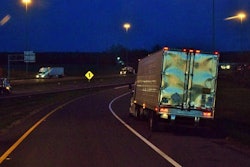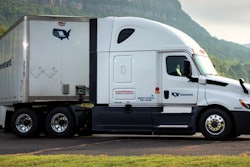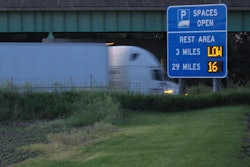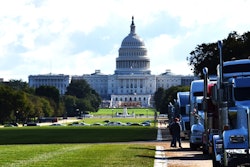Trucking has been well aware of nuclear verdicts – considered verdicts of $10 million or more – for a number of years.
A study published earlier this summer analyzes the impact of those verdicts in trucking and beyond, and what reforms are being made. The U.S. Chamber of Commerce Institute for Legal Reform’s report, Nuclear Verdicts: An Update on Trends, Causes and Solutions, looks at verdicts from 2013 to 2022 from across all sectors to identify trends and more.
The Chamber’s Nicholas Lucas joins us this week to discuss the findings of the study and how nuclear verdicts are being addressed.
Contents of this video
00:00 10-44 intro
00:26 Nuclear verdicts
01:02 Why are nuclear verdicts concerning?
02:51 Why are trucking companies susceptible to nuclear verdicts?
05:12 States with the most nuclear verdicts
06:05 Tort reform
08:05 The cycle of nuclear verdicts
09:44 Improved safety in the trucking industry
Jason Cannon:
CCJ's 10 44 is brought to you by Chevron Delo, heavy duty diesel engine oil. Now there's even more reasons to choose Delo
Matt Cole:
Nuclear verdicts continue to rise. What can be done about them?
Jason Cannon:
You're watching CCJs 10-44, a weekly episode that brings you the latest trucking industry news and updates from the editors of CCJ. Don't forget to subscribe and hit the bell for notifications so you'll never miss an installment of 10 44. Hey everybody, welcome back. I'm Jason Cannon and my co-host is Matt Cole Trucking. Has long been aware of nuclear verdicts, considered a verdict of $2 million or higher for a number of years. A study published earlier this summer takes a look at the impact of those verdicts and what sort of reforms are being made.
Matt Cole:
The US Chamber of Commerce Institute for Legal Reform's report nuclear verdicts and update on trends, causes and solutions looks at verdicts from 2013 to 2022 from across all sectors to identify trends and more. The chamber's, Nicholas Lucas joins us this week to discuss the findings of the study and how nuclear verdicts are being addressed.
Nicholas Lucas:
There are a couple of reasons why those nuclear verdicts are especially concerning to us. One is just as a baseline, they're size. So a nuclear verdict, at least when we talk about it and in our research, is a verdict that's worth $10 million or more. So anytime we talk about nuclear verdict, that's what we mean. And a $10 million verdict is an existential threat to a small business and probably to a medium sized business too. So just one of those is already a really significant factor and a really significant problem. Second reason that it's a big issue is unpredictability. So nuclear verdicts are very often very difficult to predict. You may have a set fact pattern in one case on one day in one court that results in say, a million dollar verdict, which is still a big deal, no question about that, but take that same fact pattern to a different court on a different day with different lawyers and you might get a 10 million verdict.
And the X factors in between those two verdicts have very little to do with the actual facts of the case when it comes to a nuclear verdict, oftentimes. So that makes a nuclear verdict extremely difficult to predict and adds a huge layer of complication and additional potential risk for businesses. And that kind of brings it to the third reason this is a problem, is that for any business to succeed or to successfully scale up in particular, it needs three things. It needs a good idea in the first place, of course, needs access to capital, and it needs to be able to ensure itself against risk so that it's sustainable. And so that one big accident, one big incident, doesn't just throw it completely off the rails. And when you add nuclear verdicts in the mix and that level of unpredictability, it becomes impossible to accurately assess your risk and to prepare for
Jason Cannon:
Trucking companies are particularly susceptible to nuclear verdicts, which Nicholas explains is because of a few reasons
Nicholas Lucas:
When it comes to nuclear verdicts and trucking, you've got kind of a perfect storm because when you look at personal injury and wrongful death cases involving trucking and personal injury, and wrongful death is what we were looking at in this study. Those cases often have fact patterns that have deep emotional resonance. So a jury might walk into the room and immediately connect with the plaintiff in a way that might not be true or nearly as true in other cases, even within that category of personal injury and wrongful death. And the plaintiff's bar has developed a set of tactics that are just tailor made for exploiting that vulnerability. There's a couple of different names for this. Initially, this suite of tactics was called the reptile theory. It's recently been rebranded as the Edge, but it comes to the same thing. Basically, this is a set of tactics whereby the plaintiff's lawyers will deliberately stoke fear and anger amongst the jurors.
So anger at the defendant for the alleged conduct and fear that if the defendant is not made to change their behavior, that conduct could be repeated and could impact them or their families, communities, so on. So they do that on the one hand and the second hand, the plaintiff's lawyers take that baseline of fear and anger and they add to it the message to the jurors that it's your chance, your opportunity to make a big difference. That can echo across an entire industry. You can make a decision with your verdict that will change behavior for this giant company, whatever it may be. So that combination of factors makes nuclear verdicts in trucking a real challenge.
Matt Cole:
One of the trends the report identifies is which states turn out the most nuclear verdicts. Nicholas tells us what those are, both overall and for trucking specifically, after a quick word from 10 44 sponsor Chevron lubricants,
Speaker 4:
We serve customers from Birmingham, Alabama to the Gulf coasts, so our people in our trucks are booked solid all day. There is no slack in our schedules. These trucks can't break down. I choose an engine oil that takes care of the number one issue with our engines emissions, so we don't have to worry about DPF clotting. I choose the engine oil that keeps our trucks hauling. I choose dello 600 a DM.
Nicholas Lucas:
This is not going to surprise a lot of people, I think, but you're looking at California, Florida, New York, Texas, and then Georgia and Illinois are tied for fifth place there when it comes to delivering the most nuclear verdicts. And I'll emphasize that overall, we had nearly 1300 nuclear verdicts across the study. So I think 1,288 nuclear verdicts in the 10 years we looked at. And those five states that I mentioned accounted for more than half of all of the nuclear verdicts in the study. And yes, they're the biggest states in the country, but they don't account for much more than a third of the population, but they account for well over half of the nuclear verdicts. So it's a real disproportionate count. And then specifically if you're looking at trucking, California, Texas, Florida, New Mexico, and Louisiana. So a couple of new ones, but still three of the out of those are the same ones as you get on the overall top five.
Jason Cannon:
A handful of states have already passed tort reform and a handful of others are already in the process of doing something similar to address nuclear verdicts. There is hope that that becomes a trend across the country.
Nicholas Lucas:
We certainly hope that these efforts will gain momentum and spread across the country, and there's some encouraging signs in that direction. So just over this past year, you have states like Iowa, which passed a $5 million cap on non-economic damages in cases involving commercial transportation companies. So that's important in particular because non-economic damages are those that are not linked to items that have a clear and simple price tag. So we're not talking about medical bills or repair bills for cars or anything like that. We're talking about much more ephemeral things like pain and suffering, loss of companionship stuff where there's not an easy price tag, and where plaintiff's lawyers are very good at exploiting the ambiguity there to maximize damages. You've got two really important phenomena there, the punitive damages and the non economics. So the punitive damages. So that extra category of damages that exists to really punish a defendant, they're rarer and they should be rare, though they're getting increasingly common.
But those ones are where you see just the mega nuclear verdict. So the stuff at levels like a hundred million, even billion dollar levels, that's the stuff at the real high end of the scale that pushes the averages all out of whack. To give you an example of the median overall verdict value that we saw across this study was $21 million, which is huge, but the average overall value was 89 million, which tells you that the high end of that is really freighting. The verdict values up. But when it comes to non-economic damages, so even outside the realm of punitives, we are absolutely seeing plaintiff's lawyers exploit those and really try and push those towards the ceiling, such that in six out of 10 years in our study, non-economic damages, the total value of them was greater than the punitive and economic damages combined.
Matt Cole:
Nicholas says, beyond the shock of a nuclear verdict itself, the verdicts create a vicious cycle that impacts fleets in many areas.
Nicholas Lucas:
Trucking accounts for 70% of commercial freight in the United States. So you can thank a trucker for just about anything you get off of a grocery store shelf or really anything that arrives on your front door that arrives at your doorstep. Trucking is a huge piece of the nation's economy, so anything that impacts trucking echoes further across the economy and really nuclear verdicts when it comes to trucking, create a feedback loop, a cascading feedback loop, which is bad for everybody. So lemme give you a hypothetical, say you get a slew of nuclear verdicts in a state like Texas. After those verdicts come in, insurers have to pay out for them, and then as a consequence, they raise their deductibles and they raise their rates. And the other thing they do, aside from raising deductibles and rates is that they get a lot more nervous about defending against big verdicts or cases with potential for big verdicts in court.
So they're more likely to settle and when they're more likely to settle, it means that plaintiff's lawyers can secure settlements more easily. When that signal is sent, it means you get more cases, and as you get more cases and more settlements costs rise for the insurers overall, and then naturally they have to raise rates and deductibles again. So you see that impacting the trucking industry every time we go through another cycle of this, and of course it echoes out across the broader economy really, if you want to think about this visually, you can think about it as a litigation vortex. So Lee Parsley of Texans lawsuit performed really coined that term, and I think it's a good one.
Jason Cannon:
Obviously, trucking is already improving when it comes to safety. Nicholas says, but after an accident, much of what happens in the courtroom is really out of a fleet's control.
Nicholas Lucas:
From a safety standpoint, the industry's already been doing a lot, at least that's what the numbers tell us. So last year we worked with the Scope Colitis law firm to produce a research paper called Roadblock, and within that we saw some statistics that tell us that when it comes to vehicle miles traveled, and you look at the years 2000, 2020, that the number of fatal accidents per a hundred million vehicle miles traveled by a commercial truck has fallen by about a third. So within that time span, we see what looks like a dramatic increase improvement in safety among commercial trucks. So first of all, there's already a lot that's been done, but second, I'd say that the biggest, from our perspective anyway, the biggest thing driving nuclear verdicts, I mean, it's a set of factors like the ones we've talked about a little bit. So it's those non-economic damages, it's the reptile theory, courtroom tactics like that.
And there's a few other things that we haven't talked about yet. So just really quickly, there's tactics like anchoring. So this is a practice of a plaintiff's lawyer getting in front of a jury and beginning as soon as jury selection, talking about or raising really high numbers. So saying things like, would you be comfortable delivering a $50 million verdict in this case if the facts support it? And repeating that number again and again, because what it does is it tells a juror who's trying to be fair minded that their option is to deliver zero or 50 million. So they might think, actually, to be fair, I should split it down the middle and deliver 25. Even if 25 is all out of proportion, that's the number they have as a reference point. So anchoring has been a really prevalent tactic. Another thing, trial lawyer advertising, as you and truckers are well positioned to know this, spending a lot of time on highways, those billboards are everywhere.
The plaintiffs solar billboards with giant verdict figures. So 10 million, 50 million, a billion even. A lot of these verdicts go completely undelivered, or rather they on appeal are thrown out or reduced, but they're still on the billboard. And because they're on the billboard, if you a juror, a typical juror walking into a courtroom, most people, unless it's their job, don't spend a lot of time thinking about civil justice. So most of what they know about what is a normal verdict comes from those advertisements. It's the only time they see it. So if you walk in and on your mind are those billboards and those advertisements on TV and digital so on, then your threshold for what seems reasonable is going to increase. So that's a big factor. And then finally, one other thing, pushing up verdicts all across the board, not just in trucking third party litigation funding. So this increasingly large activity of financing firms outside investors buying a share in litigation. So bankrolling a lawsuit in exchange for a percentage of the returns. It just adds another factor to the case, often unknown to the judge, to the other party, sometimes even to the plaintiff. They often work directly with the plaintiff's lawyers, but it adds another factor that is pushing for a maximal return rather than just a just return.
Jason Cannon:
That's it for this week's 10 44. You can read more on ccj digital.com. While you're there, sign up for our newsletter and stay up to date on the latest in trucking industry news and trends. If you have any questions or feedback, please let us know in the comments below. Don't forget to subscribe and hit the bell for notifications so you can catch us again next week.










